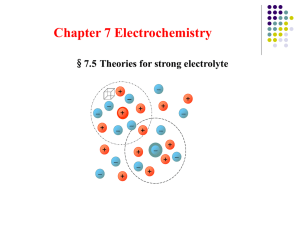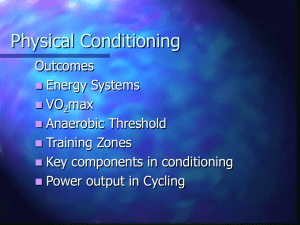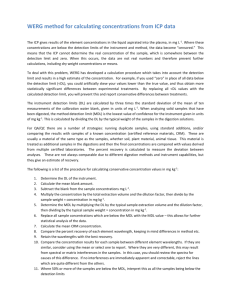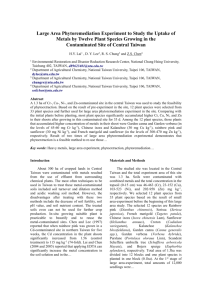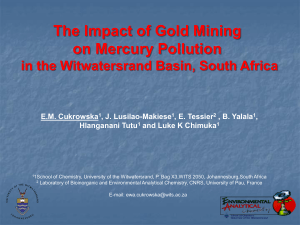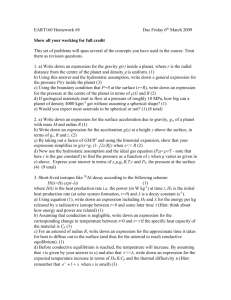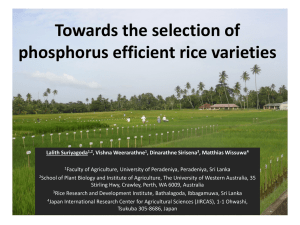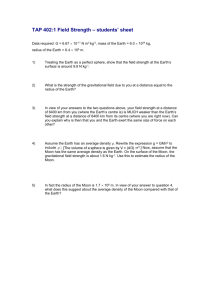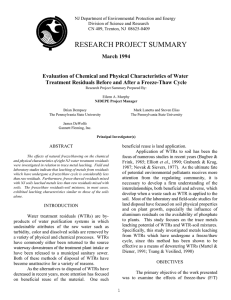Supporting Information for Comparison of metals extractability from
advertisement
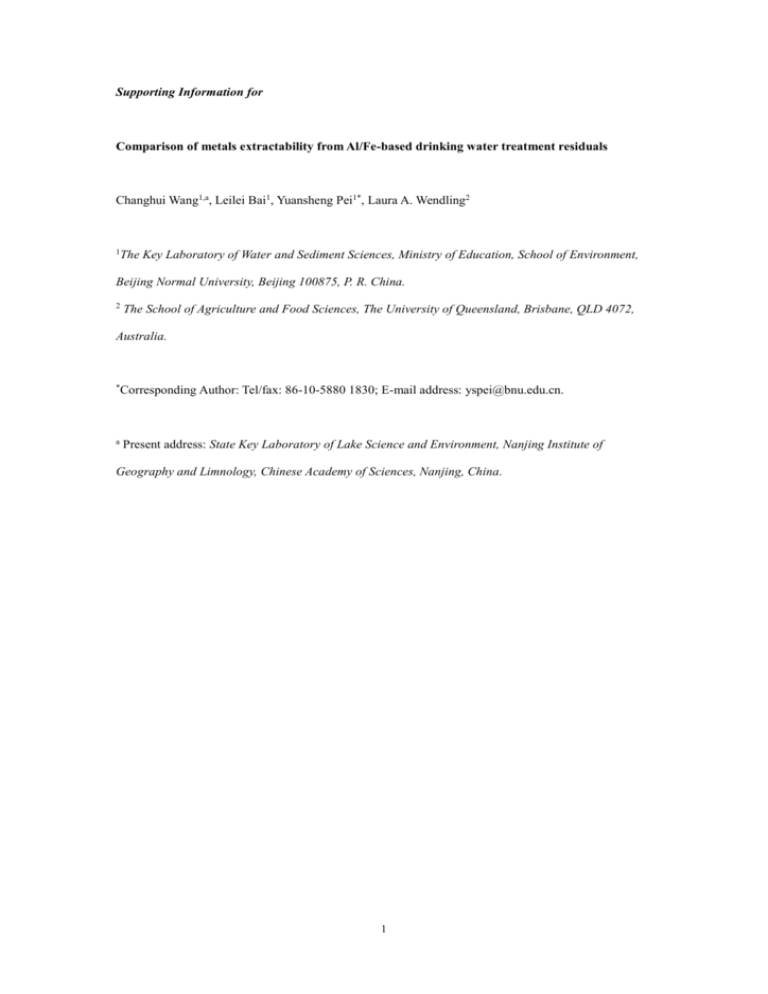
Supporting Information for Comparison of metals extractability from Al/Fe-based drinking water treatment residuals Changhui Wang1,a, Leilei Bai1, Yuansheng Pei1*, Laura A. Wendling2 1 The Key Laboratory of Water and Sediment Sciences, Ministry of Education, School of Environment, Beijing Normal University, Beijing 100875, P. R. China. 2 The School of Agriculture and Food Sciences, The University of Queensland, Brisbane, QLD 4072, Australia. * Corresponding Author: Tel/fax: 86-10-5880 1830; E-mail address: yspei@bnu.edu.cn. a Present address: State Key Laboratory of Lake Science and Environment, Nanjing Institute of Geography and Limnology, Chinese Academy of Sciences, Nanjing, China. 1 BJ-WTRs Intensity BT-WTRs GZ1-WTRs GZ2-WTRs HZ-WTRs LZ-WTRs 30 60 o Position ( 2) Fig. S1. X-ray diffraction (XRD) spectra of WTRs. 2 Fig. S2. Scanning electron microscopy (SEM) images of WTRs. 3 60 BJ BT GZ1 GZ2 HZ LZ 50 40 Cf 30 20 10 A l Fe A s Ba Be C d C o C r C u K M Mg n M o N a N i Pb Sr V Zn 0 Metals Fig. S3 The calculated metals communication factors (Cf) of WTRs. Barium, Mn and Sr within BJ-WTRs had no non-extractable fractions; therefore, the Cf of Ba, Mn and Sr for BJ-WTRs was not calculated herein. 4 Table S1 The surface elemental composition of WTRs determined by X-ray photoelectron spectroscopy (XPS).. BJ-WTRs (%) C 42 O 35 N 2.5 Cl 0.37 S 0.78 Si 7.7 Al 9.1 Fe 0.86 Ca 1.1 Mg 0.26 Na ND a not detected. Elements BT-WTRs (%) 20 48 1.0 NDa ND 18 8.1 0.84 2.8 1.4 0.33 GZ1-WTRs (%) 18 49 1.2 0.58 ND 17 12 0.85 0.65 0.38 0.35 GZ2-WTRs (%) 19 49 1.1 ND ND 15 13 0.82 0.81 0.35 0.21 5 HZ-WTRs (%) 29 44 1.2 ND ND 13 12 0.45 0.75 0.48 ND LZ-WTRs (%) 19 48 1.4 ND ND 17 11 0.63 1.9 0.97 ND Table S2 Selected properties of WTRs. Properties pH TOM (mg kg-1) HA (mg kg-1) FA (mg kg-1) HM (mg kg-1) TN (mg kg-1) TP (mg kg-1) Alox (mg kg-1) Feox (mg kg-1) SSA (m2 g-1) BJ-WTRs 7.3 107000 2000 15000 90000 12000 1400 62000 82000 61 BT-WTRs 8.5 1400 520 130 710 340 670 800 3200 9.3 GZ1-WTRs 7.9 31000 1300 3300 27000 2300 2800 14000 12000 30 6 GZ2-WTRs 7.7 23000 1300 1300 21000 2000 490 42000 28000 90 HZ-WTRs 7.4 50000 5300 7900 36000 4400 2800 70000 8900 52 LZ-WTRs 7.9 17000 1300 2600 13000 1300 950 18000 5700 34 Table S3 The calculated risk assessment code of metals within the WTRs examined herein. BJWTRs Al Ma Fe N As L Ba VHd Be M Ca VH Cd L Co L Cr L Cu L K L Mg VH Mn M Mo N Na VH Ni M Pb N Sr VH V N Zn H a represents medium risk; Elements b represents low risk; c represents no risk; d represents very high risk; e represents high risk. GZ1WTRs Lb N L He M VH H H L M L M VH N M M L H N H GZ2WTRs M N M H M VH M M L L L VH VH N H M L VH N M HZWTRs L N L VH M VH H L L L L L VH N H L L VH N M 7 LZWTRs Nc N L H L VH H L L L L M H N M L L VH N L BTWTRs N N L H L VH H L N L L M H N M L L VH N L Table S4 Results of Pearson correlation analyses between the results of bioaccessible extraction and fractionation for each metal in the WTRs. Elements Bioaccessibility Aa 0.91* b Al A+R 0.90* A+R+Oc 0.95** A 0.37 Fe A+R 0.82* A+R+O 0.95* A 0.97** As A+R 0.93** A+R+O 0.21 A 0.92** Ba A+R 0.96** A+R+O 0.93** A 0.81 Be A+R 0.82* A+R+O 0.96** A -0.55 Ca A+R -0.48 A+R+O -0.51 A 0.81 Cd A+R 0.75 A+R+O 0.047 A 0.73 Co A+R 0.73 A+R+O 0.83* A 0.86* Cr A+R 0.84* A+R+O 0.86* A 0.91* Cu A+R 0.89* A+R+O 0.80 a represents acid-soluble metal; Elements A A+R A+R+O A A+R A+R+O A A+R A+R+O A A+R A+R+O A A+R A+R+O A A+R A+R+O A A+R A+R+O A A+R A+R+O A A+R A+R+O A A+R A+R+O K Mg Mn Mo Na Ni Pb Sr V Zn Bioaccessibility 0.81 0.78 0.76 0.98** 0.98** 0.98** 0.98** 0.20 0.23 NCd NC -0.049 0.72 0.80 0.86* 0.96* 0.90* 0.93* 0.94* 0.80 -0.56 0.96** 0.95** 0.88* NC 0.46 0.25 0.39 0.50 0.49 b represents the sum of acid-soluble metal and reducible metal; c represents the sum of acid-soluble metal, reducible metal and oxidizable metal; d not calculated; * significant correlation was found at P < 0.05; ** significant correlation was found at P < 0.01. 8 Table S5 Results of Pearson correlation analyses between the results of fractionation and TCLP anylysis for each metal in the WTRs. Correlation coefficient Al -0.71 Fe -0.75 As 0.42 Ba -0.60 Be -0.96* Ca -0.79 Cd 0.53 Co 0.083 Cr -0.60 Cu -0.077 a not calculated; Elements Correlation coefficient 0.81 0.88* 0.43 NCa -0.20 0.16 0.59 NC -0.40 Elements K Mg Mn Mo Ni Pb Sr V Zn * significant correlation at P < 0.05. 9 Table S6 Regulatory limits for metals in biosolids based on guidelines from China, the EU, the Netherlands and the USA. USAc (mg kg-1) Ceiling concentration Pollutant concentration limit 75 41 2. 85 39 600 4300 1200 600 3000 1500 200 840 300 2.0 57 17 75 200 100 30 420 420 100 36 3000 1500 300 7500 2800 a refers to Ministry of Environmental Protection of the People’s Republic of China (2009); Contaminates As Cd Cr Cu Pb Hg Mo Ni Se Zn Chinaa (mg kg-1) 75 15 1000 1500 1000 15 EU limitb (mg kg-1) b refers to Iranpour (2004); c refers to USEPA (1995). Netherlands limitb (mg kg-1) 15 1.25 75 75 100 0.75 In comparison to the Chinese regulatory guidelines for land application of sewage sludge, the respective total contents of As (11-56 mg kg-1), Cd (0.30-1.3 mg kg-1), Cr (29-89 mg kg-1), Cu (22-140 mg kg-1), Hg (not detected), Ni (15-75 mg kg-1), Pb (10-200 mg kg-1) and Zn (60-410 mg kg-1) in the WTRs (Table 1) were less than the maximum guideline levels (Ministry of Environmental Protection of the People’s Republic of China, 2009). Total quantities of all metals within the WTRs were also within regulatory guidelines in the EU and less than US ceiling (maximum) concentration limits (USEPA 1995; Iranpour et al. 2004). In addition to maximum (ceiling) concentrations, the US regulatory guidelines for land application of sewage sludge also give pollutant concentration limits. If one or more of these concentration limits are not met but the concentration is less than the ceiling concentration, the total quantity of sewage sludge for land application is restricted. In comparison to these US pollutant concentration limits, only As in BJ-WTRs (56 mg kg-1) was greater than the pollutant concentration limit (41 mg kg-1; USEPA 1995). In addition, according to the regulatory guidelines in New Zealand, the total As and Cd content of BJ-WTRs, total As in BT-WTRs, total As, Cr, Cu and Ni in GZ1-WTRs, total Pb in GZ2-WTRs, total As and Zn in HZ-WTRs and the total As and Ni contents of LZ-WTRs were greater than the regulatory limits (Iranpour et al. 2004). Therefore, land application of the WTRs investigated in the present study could be allowed in China and the EU, and with the exception of the BJ-WTRs which would be subject to application limits based on their As content, land application of other WTRs investigated would not be restricted in the USA. In contrast, none of the WTRs would be suitable for land application in New Zealand. 10 11 References Iranpour R, Cox HHJ, Kearney RJ, Cleark JH, Pincince AB, Daigger GT (2004) Regulations for biosolids land application in U.S. and European Union. J Residuals Sci Tech 1:209-222. Ministry of Environmental Protection of the People’s Republic of China (2009) GJ/T 309-2009: Disposal of sludge from municipal wastewater treatment plant — Control standards for agricultural use. China Environmental Science Press, Beijing. USEPA (1995) A Guide to the biosolids risk assessments for the EPA part 503 rule. EPA-832-B-93-005. U.S. Environmental Protection Agency, Washington, D.C. 12
